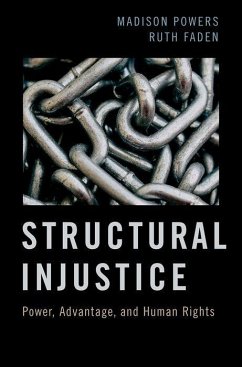Powers
Structural Injustice
Powers
Structural Injustice
- Gebundenes Buch
- Merkliste
- Auf die Merkliste
- Bewerten Bewerten
- Teilen
- Produkt teilen
- Produkterinnerung
- Produkterinnerung
Structural Injustice advances a theory of what structural injustice is and how it works. Powers and Faden present both a philosophically powerful, integrated theory about human rights violations and structural unfairness, alongside practical insights into how to improve them.
Andere Kunden interessierten sich auch für
![Epistemic Injustice Epistemic Injustice]() Miranda FrickerEpistemic Injustice28,99 €
Miranda FrickerEpistemic Injustice28,99 €![Criminal Testimonial Injustice Criminal Testimonial Injustice]() Jennifer LackeyCriminal Testimonial Injustice95,99 €
Jennifer LackeyCriminal Testimonial Injustice95,99 €![Human Rights, Ownership, and the Individual Human Rights, Ownership, and the Individual]() Rowan CruftHuman Rights, Ownership, and the Individual120,99 €
Rowan CruftHuman Rights, Ownership, and the Individual120,99 €![Epistemic Injustice Epistemic Injustice]() Miranda FrickerEpistemic Injustice156,99 €
Miranda FrickerEpistemic Injustice156,99 €![Rights and Their Limits Rights and Their Limits]() F M KammRights and Their Limits49,99 €
F M KammRights and Their Limits49,99 €![Refugees and the Ethics of Forced Displacement Refugees and the Ethics of Forced Displacement]() Serena ParekhRefugees and the Ethics of Forced Displacement227,99 €
Serena ParekhRefugees and the Ethics of Forced Displacement227,99 €![The Beneficiary The Beneficiary]() Bruce RobbinsThe Beneficiary118,99 €
Bruce RobbinsThe Beneficiary118,99 €-
-
-
Structural Injustice advances a theory of what structural injustice is and how it works. Powers and Faden present both a philosophically powerful, integrated theory about human rights violations and structural unfairness, alongside practical insights into how to improve them.
Hinweis: Dieser Artikel kann nur an eine deutsche Lieferadresse ausgeliefert werden.
Hinweis: Dieser Artikel kann nur an eine deutsche Lieferadresse ausgeliefert werden.
Produktdetails
- Produktdetails
- Verlag: Oxford University Press
- Seitenzahl: 324
- Erscheinungstermin: 27. September 2019
- Englisch
- Abmessung: 238mm x 159mm x 28mm
- Gewicht: 596g
- ISBN-13: 9780190053987
- ISBN-10: 0190053984
- Artikelnr.: 55452739
- Herstellerkennzeichnung
- Libri GmbH
- Europaallee 1
- 36244 Bad Hersfeld
- gpsr@libri.de
- Verlag: Oxford University Press
- Seitenzahl: 324
- Erscheinungstermin: 27. September 2019
- Englisch
- Abmessung: 238mm x 159mm x 28mm
- Gewicht: 596g
- ISBN-13: 9780190053987
- ISBN-10: 0190053984
- Artikelnr.: 55452739
- Herstellerkennzeichnung
- Libri GmbH
- Europaallee 1
- 36244 Bad Hersfeld
- gpsr@libri.de
Madison Powers is Professor of Philosophy, Francis J. McNamara, Jr. Chair, and Senior Research Scholar, Kennedy Institute of Ethics, Georgetown University. His current research focus is on environmental justice, especially issues of natural resource ownership and use, human rights, global supply chains, and global development. Ruth Faden is the founder of the Johns Hopkins Berman Institute of Bioethics, it's Director from 1995 until 2016, and the inaugural Philip Franklin Wagley Professor of Biomedical Ethics. Dr. Faden's current research focuses on structural injustice theory, and on justice challenges in food and agriculture, health systems, and biomedical science.
* Preface
* Chapter 1: Introduction
* 1.1 Structural Injustice
* 1.2 Plan of the Chapters
* Chapter 2: Well-Being
* 2.1. The place of well-being in our theory
* 2.2. The Socratic and structural dependence arguments
* 2.3. The core elements
* 2.4. A decent human life
* 2.5. An alternative to universal endorsement approaches to
justification
* 2.6. Three implications of the roles of our conception of well-being
* Chapter 3: What justice is
* 3.1. Moral importance and stringency
* 3.2. Claimability and specificity
* 3.3. Rightful enforceability
* 3.4. Unfairness norms
* Chapter 4: what structural injustice is
* 4.1. Significant impacts, structural components, and social groups
* 4.2. Social structural components and their systematic influence
* 4.3. Power, advantage, and social position
* 4.4. Background assumptions
* Chapter 5: Well-being ad human rights
* 5.1. The function of rights
* 5.2. Dignity and well-being interests
* 5.3. The social functions of human rights
* 5.4. Counterpart duties and general responsibilities: a pragmatic
approach
* Chapter 6: The Responsibility of States
* 6.1. The normative uniqueness of state agency and its implications
* 6.2. The Strong Statist Challenge
* 6.3. National self-determination arguments
* 6.4. The Principle of Interstate Reciprocity
* 6.5. The power of non-State institutions in the current global order
* Chapter 7: Real-World Examples
* 7.1. National sacrifice zones: from Appalachia to Warren County
* 7.2. The globalization of sacrifice zones
* 7.3. Segregated cities: "two societies,... separate and unequal"
* 7.4. Urban 'slums': the proliferation of informal human settlements
* Chapter 8: Resistance to injustice: activism and social movements
* 8.1. Individual responsibility in a nearly just society
* 8.2. Means and goals of resistance in less ideal circumstances
* 8.3. Targets of resistance: contributors and beneficiaries
* 8.4. Conclusion: well-being and social movements
* Bibliography
* Chapter 1: Introduction
* 1.1 Structural Injustice
* 1.2 Plan of the Chapters
* Chapter 2: Well-Being
* 2.1. The place of well-being in our theory
* 2.2. The Socratic and structural dependence arguments
* 2.3. The core elements
* 2.4. A decent human life
* 2.5. An alternative to universal endorsement approaches to
justification
* 2.6. Three implications of the roles of our conception of well-being
* Chapter 3: What justice is
* 3.1. Moral importance and stringency
* 3.2. Claimability and specificity
* 3.3. Rightful enforceability
* 3.4. Unfairness norms
* Chapter 4: what structural injustice is
* 4.1. Significant impacts, structural components, and social groups
* 4.2. Social structural components and their systematic influence
* 4.3. Power, advantage, and social position
* 4.4. Background assumptions
* Chapter 5: Well-being ad human rights
* 5.1. The function of rights
* 5.2. Dignity and well-being interests
* 5.3. The social functions of human rights
* 5.4. Counterpart duties and general responsibilities: a pragmatic
approach
* Chapter 6: The Responsibility of States
* 6.1. The normative uniqueness of state agency and its implications
* 6.2. The Strong Statist Challenge
* 6.3. National self-determination arguments
* 6.4. The Principle of Interstate Reciprocity
* 6.5. The power of non-State institutions in the current global order
* Chapter 7: Real-World Examples
* 7.1. National sacrifice zones: from Appalachia to Warren County
* 7.2. The globalization of sacrifice zones
* 7.3. Segregated cities: "two societies,... separate and unequal"
* 7.4. Urban 'slums': the proliferation of informal human settlements
* Chapter 8: Resistance to injustice: activism and social movements
* 8.1. Individual responsibility in a nearly just society
* 8.2. Means and goals of resistance in less ideal circumstances
* 8.3. Targets of resistance: contributors and beneficiaries
* 8.4. Conclusion: well-being and social movements
* Bibliography
* Preface
* Chapter 1: Introduction
* 1.1 Structural Injustice
* 1.2 Plan of the Chapters
* Chapter 2: Well-Being
* 2.1. The place of well-being in our theory
* 2.2. The Socratic and structural dependence arguments
* 2.3. The core elements
* 2.4. A decent human life
* 2.5. An alternative to universal endorsement approaches to
justification
* 2.6. Three implications of the roles of our conception of well-being
* Chapter 3: What justice is
* 3.1. Moral importance and stringency
* 3.2. Claimability and specificity
* 3.3. Rightful enforceability
* 3.4. Unfairness norms
* Chapter 4: what structural injustice is
* 4.1. Significant impacts, structural components, and social groups
* 4.2. Social structural components and their systematic influence
* 4.3. Power, advantage, and social position
* 4.4. Background assumptions
* Chapter 5: Well-being ad human rights
* 5.1. The function of rights
* 5.2. Dignity and well-being interests
* 5.3. The social functions of human rights
* 5.4. Counterpart duties and general responsibilities: a pragmatic
approach
* Chapter 6: The Responsibility of States
* 6.1. The normative uniqueness of state agency and its implications
* 6.2. The Strong Statist Challenge
* 6.3. National self-determination arguments
* 6.4. The Principle of Interstate Reciprocity
* 6.5. The power of non-State institutions in the current global order
* Chapter 7: Real-World Examples
* 7.1. National sacrifice zones: from Appalachia to Warren County
* 7.2. The globalization of sacrifice zones
* 7.3. Segregated cities: "two societies,... separate and unequal"
* 7.4. Urban 'slums': the proliferation of informal human settlements
* Chapter 8: Resistance to injustice: activism and social movements
* 8.1. Individual responsibility in a nearly just society
* 8.2. Means and goals of resistance in less ideal circumstances
* 8.3. Targets of resistance: contributors and beneficiaries
* 8.4. Conclusion: well-being and social movements
* Bibliography
* Chapter 1: Introduction
* 1.1 Structural Injustice
* 1.2 Plan of the Chapters
* Chapter 2: Well-Being
* 2.1. The place of well-being in our theory
* 2.2. The Socratic and structural dependence arguments
* 2.3. The core elements
* 2.4. A decent human life
* 2.5. An alternative to universal endorsement approaches to
justification
* 2.6. Three implications of the roles of our conception of well-being
* Chapter 3: What justice is
* 3.1. Moral importance and stringency
* 3.2. Claimability and specificity
* 3.3. Rightful enforceability
* 3.4. Unfairness norms
* Chapter 4: what structural injustice is
* 4.1. Significant impacts, structural components, and social groups
* 4.2. Social structural components and their systematic influence
* 4.3. Power, advantage, and social position
* 4.4. Background assumptions
* Chapter 5: Well-being ad human rights
* 5.1. The function of rights
* 5.2. Dignity and well-being interests
* 5.3. The social functions of human rights
* 5.4. Counterpart duties and general responsibilities: a pragmatic
approach
* Chapter 6: The Responsibility of States
* 6.1. The normative uniqueness of state agency and its implications
* 6.2. The Strong Statist Challenge
* 6.3. National self-determination arguments
* 6.4. The Principle of Interstate Reciprocity
* 6.5. The power of non-State institutions in the current global order
* Chapter 7: Real-World Examples
* 7.1. National sacrifice zones: from Appalachia to Warren County
* 7.2. The globalization of sacrifice zones
* 7.3. Segregated cities: "two societies,... separate and unequal"
* 7.4. Urban 'slums': the proliferation of informal human settlements
* Chapter 8: Resistance to injustice: activism and social movements
* 8.1. Individual responsibility in a nearly just society
* 8.2. Means and goals of resistance in less ideal circumstances
* 8.3. Targets of resistance: contributors and beneficiaries
* 8.4. Conclusion: well-being and social movements
* Bibliography








